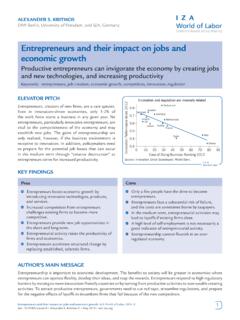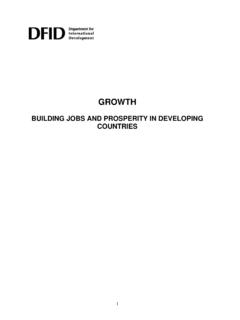Transcription of The impact of the COVID-19 pandemic on jobs and incomes …
1 The impact of the COVID-19 pandemic on jobs and incomes in G20 economies ILO-OECD paper prepared at the request of G20 Leaders Saudi Arabia's G20 Presidency 2020. 2020. 2 . Table of contents Executive summary 3. Introduction 6. 1. From an unprecedented health crisis to a deep economic crisis 6. Evolution and current scale of the health crisis across countries 6. Timing and extent of health containment measures and their impact on mobility 6. Macroeconomic consequences 9. 2. Diagnosis: A heavy and immediate toll on labour markets 10. An unprecedented collapse in employment and hours worked 10.
2 The rise in unemployment has been muted in many countries 12. Change in wages and incomes 14. The unequal impact of the crisis 14. 3. Mitigation: Policies to mitigate the labour market consequences of the crisis 20. Reducing workers' exposure to COVID-19 in the workplace 21. Securing jobs , supporting companies and maintaining essential service provision 25. Providing income security and employment support to affected workers 29. 4. Recovery: Policy considerations for exiting confinement 36. 5. Building back better 41. References 43. Tables Table 1.
3 A severe decline in working hours and employment projected in G20 economies 12. Figures Figure 1. G20 economies have differed in timing and strictness of COVID-19 containment measures 7. Figure 2. Individual mobility fell substantially in most G20 countries 8. Figure 3. Industrial production was severely curtailed by containment measures 9. Figure 4. Output is set to remain weak for an extended period 10. Figure 5. Unprecedented falls in employment and total hours worked 11. Figure 6. Declines in labour force participation have muted rises in unemployment 13.
4 Figure 7. Distribution of informal employment in G20 economies 16. Figure 8. Employment losses for young people have been disproportionally large 17. Figure 9. Unemployment has risen much more for younger people than older adults 18. Figure 10. Women in informal employment are overrepresented in high risk sectors 19. Figure 11. A substantial shift to working from home occurred during the pandemic 21. Figure 12. Participation in job retention schemes across G20 countries 26. Boxes Box 1. Measures taken by the European Union 28. Box 2.
5 The role of social dialogue and social partners during the COVID-19 crisis: spotlight on G20 countries 33. 3. Executive summary During the initial weeks and months of the COVID-19 crisis, G20 countries moved rapidly to provide unprecedented levels of emergency support to keep households and companies afloat, protect jobs and incomes and prevent the economy from collapsing. In the coming months, as the peak of the COVID-19 . pandemic subsides and G20 countries increasingly turn to re-opening their economies, policymakers will need to maintain this agility, modifying and adjusting the composition and characteristics of support packages, targeting support where it is needed most, and encouraging a return to work where possible.
6 While doing that, it will be important to start on the task of building back better to address the deep-rooted labour market fragilities and structural inequalities that the pandemic has exposed. Alongside efforts to address the health emergency brought about by the COVID-19 pandemic , countries across the G20 have adopted a vast range of emergency measures aimed at supporting firms' liquidity in the face of mandatory business restrictions, quarantines and plummeting activity. Among these measures, government-financed short time work and wage subsidy schemes, have been adopted in a number of G20.
7 Countries to minimise job losses. These schemes, which allow firms experiencing a temporary lull in business, to receive support for a share of the wages of employees working reduced hours, appear to have averted a massive initial surge in unemployment in these countries. The expansion of the coverage and level of sickness benefits and paid sick and care leave in many countries also played an important role protecting the jobs , incomes and health of workers. In spite of governments' bold efforts to support firms and protect jobs through job retention schemes, millions of workers across the G20 have lost their jobs .
8 Meanwhile, many self-employed workers saw their incomes collapse. Therefore, the majority of G20 countries took immediate steps to improve the accessibility to, and generosity of, unemployment minimum-income benefits. Alongside these efforts, several countries introduced new cash transfers targeted at those who remained without cover, supported expenses or, in a number of cases, introduced universal transfers to ensure no one fell through the cracks. Providers of private and public employment services (PES) have been placed under a severe stress test as demand for their services sky-rocketed in the first few months of the crisis while their capacity was severely constrained by the need to curtail face-to-face contact with job seekers.
9 Governments responded by simplifying procedures for claiming benefits and ramping up the digitalisation of services such as registering for job search assistance and applying for benefits. Opportunities for online learning were also increased. The economic consequences of the COVID-19 pandemic have not fallen with equal severity on all shoulders. Existing vulnerabilities have been exposed, and inequalities entrenched. Many of those with more limited means and protection, such as workers in informal employment or in diverse work arrangements, have been the least able to face the consequences of the crisis.
10 Job and income losses have been particularly severe for women. Many women still working have been on the frontline in providing essential services while risking exposure to the coronavirus. Moreover, the increased burden of unpaid care brought by the crisis has particularly affected women. This raises the risk that the progress many G20 countries have made on gender equality over past decades may be put on hold or even reversed. In addition, the COVID-19 has been a sombre reminder of the higher risk of violence and harassment facing women during times of crisis.


















